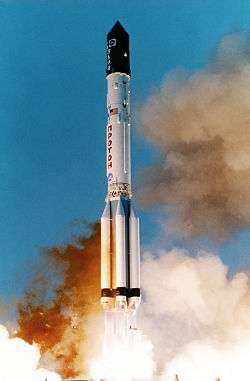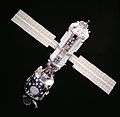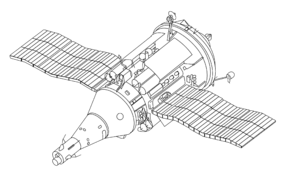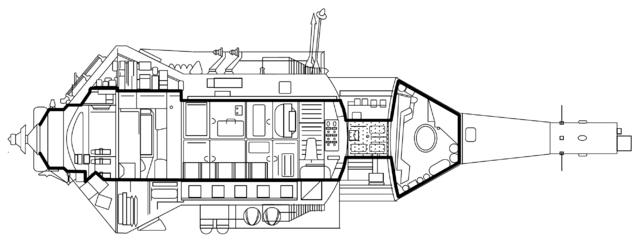Zarya
Zarya (Russian: Заря́, lit. 'Dawn'[lower-alpha 2]), also known as the Functional Cargo Block or FGB (from the Russian: "Функционально-грузовой блок", lit. 'Funktsionalno-gruzovoy blok' or ФГБ), is the first module of the International Space Station to have been launched.[2] The FGB provided electrical power, storage, propulsion, and guidance to the ISS during the initial stage of assembly. With the launch and assembly in orbit of other modules with more specialized functionality, Zarya is now primarily used for storage, both inside the pressurized section and in the externally mounted fuel tanks. The Zarya is a descendant of the TKS spacecraft designed for the Russian Salyut program. The name Zarya ("Dawn") was given to the FGB because it signified the dawn of a new era of international cooperation in space. Although it was built by a Russian company, it is owned by the United States.[3]
 | |
| Module statistics | |
|---|---|
| COSPAR ID | 1998-067A |
| Launch date | 20 November 1998 |
| Launch vehicle | Proton-K |
| Mass | 19,323 kilograms (42,600 lb) (initial in orbit mass, including 3,800 kilograms (8,400 lb) propellants) [1] |
| Length | 12.56 metres (41.2 ft) |
| Diameter | 4.11 metres (13.5 ft) |
| Configuration | |
_module.svg.png) Parts of Zarya[lower-alpha 1] | |

Construction
The FGB design was originally intended as a module for the Russian Mir space station, but was not flown as of the end of the Mir program. A FGB cargo block was incorporated as lution of the Energiya Rocket Family.[4] With the end of the Mir program, the design was adapted to use for the International Space Station.
The Zarya module is capable of station keeping and provides sizable battery power; it was suggested to have initially been built to both power and control the recoil from a further derivation of the then classified Skif laser system/Polyus satellite. Commentators in the West thought that the Zarya module was constructed cheaper and lifted to orbit faster than what should have been possible in the post-Soviet era, and that the FGB might have been largely constructed from mothballed hardware from the Skif laser program (which had been canceled after the failed 1987 Polyus launch).[5]
The research and development of a similar design was paid for by Russia and the Soviet Union, the design of the module and all systems are Soviet/Russian. The United States funded Zarya through the U.S. prime contracts in the 1990s as the first module for ISS. Built from December 1994 to January 1998 in Russia at the Khrunichev State Research and Production Space Center (KhSC) in Moscow,[2] its control system was developed by the Khartron Corp. (Kharkiv, Ukraine). The module was included as part of NASA's plan for the International Space Station (ISS) instead of Lockheed Martin's "Bus-1" option because it was significantly cheaper (US$220 million vs. $450 million). As part of the contract Khrunichev constructed much of an identical module (referred to as "FGB-2") for contingency purposes. FGB-2 has been proposed for a variety of projects; it is now slated to be used to construct the Russian Multipurpose Laboratory Module Nauka.

Design
Zarya has a mass of 19,323 kilograms (42,600 lb), is 12.56 meters (41.2 ft) long and 4.11 meters (13.5 ft) wide at its widest point.
The module has three docking ports: one axially on the front end at the docking sphere, one on the earth-facing side (nadir) of the docking sphere and one axially on the aft end. Attached to the forward port is the Pressurized Mating Adapter PMA-1, which in turn is connected to the Unity Module – this is the connection between the Russian Orbital Segment (ROS) and the US Orbital Segment (USOS). Attached to the aft port is the Zvezda Service Module. The lower port (nadir) was initially used by visiting Soyuz spacecraft and Progress spacecraft to dock to the ROS; The Rassvet module is now docked semipermanently on the nadir port of Zarya, and visiting spacecraft use Rassvet's nadir docking port instead.[6]
Zarya has two solar arrays measuring 10.67 by 3.35 meters (35.0 by 11.0 ft) and six nickel-cadmium batteries that can provide an average of 3 kilowatts (4.0 hp) of power – the solar arrays have been however retracted so the P1/S1 radiators of the Integrated Truss Structure could deploy. Zarya has 16 external fuel tanks that can hold up to 6.1 tonnes (13,000 lb) of propellant (this requirement was mandated by NASA in early 1997 over concerns that the Zvezda Service Module would be further delayed, hence the FGB had to be capable of independent propellant storage and transfer from Progress spacecraft even without Zvezda [7]). Zarya also has 24 large steering jets, 12 small steering jets, and two large engines that were used for reboost and major orbital changes; with the docking of Zvezda these are now permanently disabled. Since they are no longer needed for Zarya's engines, Zarya's propellant tanks are now used to store additional fuel for Zvezda.
Launch and flight

Zarya was launched on 20 November 1998 on a Russian Proton rocket from Baikonur Cosmodrome Site 81 in Kazakhstan to a 400 km (250 mi) high orbit with a designed lifetime of at least 15 years. After Zarya reached orbit, STS-88 launched on 4 December 1998 to attach the Unity module.
Although only designed to fly autonomously for six to eight months, Zarya was required to do so for almost two years due to delays to the Russian Service Module, Zvezda. Zvezda was finally launched on 12 July 2000, docking with Zarya on 26 July 2000.
Zarya passed the 50,000-orbit mark at 15:17 UTC on 14 August 2007 during the STS-118 mission to the International Space Station.
Dockings
- Nadir
| Spacecraft | Launch (UTC) | Carrier rocket |
Launch pad |
Docking | Undocking | Deorbit | Remarks |
|---|---|---|---|---|---|---|---|
| Progress M1-4[8] | 16 November 2000 01:32:36 | Soyuz-U | Site 1/5 | 18 November 03:48 |
1 December 16:23 |
8 February 13:50 |
ISS-2P. The automatic Kurs docking system failed, and the manual backup, TORU, was used for the docking. Following undocking, Progress M1-4 spent 25 days in free flight, prior to redocking with the same port.[9] |
| 26 December 10:54 |
8 February 2001 11:26 | ||||||
| Progress M-64 | 14 May 2008 20:22:56 |
Soyuz-U | Site 1/5 | 16 May 2008 21:39 |
1 September 2008 19:46 |
8 September 2008 21:33 |
ISS-29P |
- Rassvet, 2010–Present
- Forward
- Aft
- Zvezda, 2000–Present
Gallery
 Interior of Zarya
Interior of Zarya Zarya (top) and Unity (Node 1)
Zarya (top) and Unity (Node 1) Zarya as seen in 2009 during STS-128, solar arrays folded
Zarya as seen in 2009 during STS-128, solar arrays folded View through the window of Zarya, 2006
View through the window of Zarya, 2006
Notes
-
- Air Ducts
- Communications Panel
- Caution and Warning Systems Panel
- Contaminant Filters
- Contingency Transfer (Water)/Container Bag
- Contingency Transfer (Water)/Container Connections
- Dust Collectors
- Electrical Outlet
- Flex Airduct Container
- Fuse
- Fuse Panels (behind close-outs)
- Gas Analyzer
- Gas Mask
- Handrail
- Hatch Protection
- Instrument Containers
- Docking Port to PMA-1
- Laptop Outlets
- Lighting Panel
- Lights
- Docking Port to Rassvet
- Onboard Documentation
- Onboard Network Receptacle Outlets
- Pole and Hook
- Portable Fans
- Removable Fire Extinguisher
- Power Outlet
- Pressurized Valve Unit
- Caution and Warning Panel
- Smoke Detector
- TV Outlet
- Wipes/Filters
- "Zarya" can have a lot of meanings: "daybreak", "dawn" (in the morning) or "afterglow", "evening glow", "sunset" (in the evening). But usually it means "dawn".
References
- Hendrickx, Bart (15 October 2015). "From Mir-2 to the ISS Russian Segment" (PDF). BIS. Retrieved 24 May 2020.
- NASA, International Space Station, Zarya (accessed 19 Apr. 2014)
- Zak, Anatoly (15 October 2008). "Russian Segment: Enterprise". RussianSpaceWeb. Retrieved 4 August 2012.
- J. British Interplanetary Soc., Vol. 55, pp. 242-278 (2002).
- https://web.archive.org/web/20130926143351/http://arstechnica.com/science/2013/05/the-soviet-response-to-star-wars-that-never-was/2/
- Reference Guide to the International Space Station by Gary Kitmacher, pp. 24-25 (2006), Apogee Books, ISBN 1-894959-34-5.
- Hendrickx, Bart (15 October 2015). "From Mir-2 to the ISS Russian Segment (p.19)" (PDF). BIS. Retrieved 24 May 2020.
- Wade, Mark. "Progress M1". Encyclopedia Astronautica. Archived from the original on 2009-08-03. Retrieved 2008-12-26.
- Anikeev, Alexander. "Cargo spacecraft "Progress M1-4"". Manned Astronautics - Figures & Facts. Archived from the original on 2007-10-09. Retrieved 2009-06-07.


